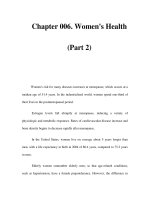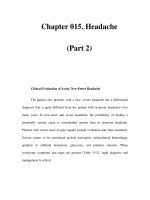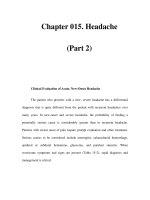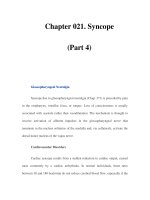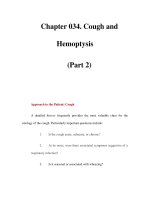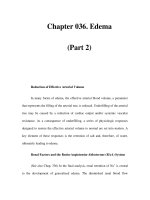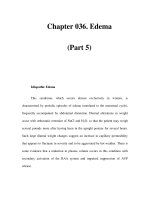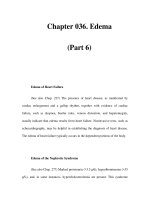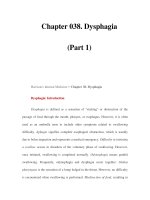Chapter 038. Dysphagia (Part 2) ppsx
Bạn đang xem bản rút gọn của tài liệu. Xem và tải ngay bản đầy đủ của tài liệu tại đây (15.67 KB, 8 trang )
Chapter 038. Dysphagia
(Part 2)
Pathophysiology of Dysphagia
Based on anatomic site of involvement, dysphagia may be divided into
oral, pharyngeal, and esophageal dysphagia. Normal transport of an ingested bolus
through the swallowing passage depends on the size of the ingested bolus and size
of the lumen, the force of peristaltic contraction, and deglutitive inhibition,
including normal relaxation of UES and LES during swallowing. Dysphagia
caused by a large bolus or a narrow lumen is called mechanical dysphagia,
whereas dysphagia due to weakness of peristaltic contractions or to impaired
deglutitive inhibition causing nonperistaltic contractions and impaired sphincter
relaxation is called motor dysphagia.
ORAL AND PHARYNGEAL (OROPHARYNGEAL) DYSPHAGIA
Oral-phase dysphagia is associated with poor bolus formation and control,
so that food may either drool out of the mouth or overstay in the mouth or the
patient may experience difficulty in initiating the swallowing reflex. Poor bolus
control may also lead to premature spillage of food into the pharynx and aspiration
into the unguarded larynx and/or nasal cavity. Pharyngeal-phase dysphagia is
associated with stasis of food in the pharynx due to poor pharyngeal propulsion
and obstruction at the UES. Pharyngeal stasis leads to nasal regurgitation and
laryngeal aspiration during or after a swallow. Nasal regurgitation and laryngeal
aspiration during the process of swallowing are hallmarks of oropharyngeal
dysphagia.
Oropharyngeal dysphagia may be due to mechanical causes, including a
variety of developmental abnormalities, head and neck tumors, radiation therapy,
and inflammatory processes (Table 38-1).
Table 38-1 Oropharyngeal Dysphagia
Oropharyngeal Mechanical Dysphagia
I. Wall defects
A. Congenital
1. Cleft lip, cleft palate
2. Laryngeal clefts
B. Post surgical
II. Intrinsic narrowing
A. Inflammatory
1. Viral (herpes simplex, varicella-zoster, cytomegalovirus)
2. Bacterial (peritonsillar abscess)
3. Fungal (Candida)
4. Mucocutaneous bullous diseases
5. Caustic, chemical, thermal injury
B. Web
1. Plummer-Vinson syndrome
C. Strictures
1. Congenital microganthia
2. Caustic ingestion
3. Post-radiation
D. Tumors
1. Benign
2. Malignant
III. Extrinsic compression
A. Retropharyngeal abscess, mass
B. Zenker's diverticulum
C. Thyroid disorders
D. Vertebral osteophytes
Oropharyngeal Motor Dysphagia
I. Diseases of cerebral cortex and brainstem
A. With altered consciousness or dementia
1. Dementias including Alzheimer's disease
2. Altered consciousness, metabolic encephalopathy, encephalitis,
meningitis, cerebrovascular accident, brain injury
B. With normal cognitive functions
1. Brain injury
2. Cerebral palsy
3. Rabies, tetanus, neurosyphilis
4. Cerebrovascular disease
5. Parkinson's disease and other extrapyramidal lesions
6. Multiple sclerosis (bulbar and pseudobulbar palsy)
7. Amyotrophic lateral sclerosis (motor neuron disease)
8. Poliomyelitis and post-poliomyelitis syndrome
II. Diseases of cranial nerves (V, VII, IX, X, XII)
A. Basilar meningitis (chronic inflammatory, neoplastic)
B. Nerve injury
C. Neuropathy (Guillain-Barré syndrome, familial dysautonomia, sarcoid,
diabetic and other causes)
III. Neuromuscular
A. Myasthenia gravis
B. Eaton-Lambert syndrome
C. Botulinum toxin
D. Aminoglycoside and other drugs
IV. Muscle disorders
A. Myositis (polymyositis, dermatomyositis, sarcoidosis)
B. Metabolic myopathy (mitochondrial myopathy, thyroid myopathy)
C. Primary myopathies (myotonic dystrophy, oculopharyngeal myopathy)
